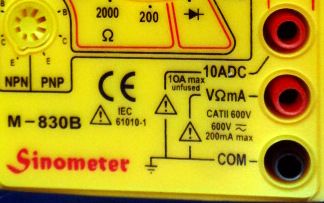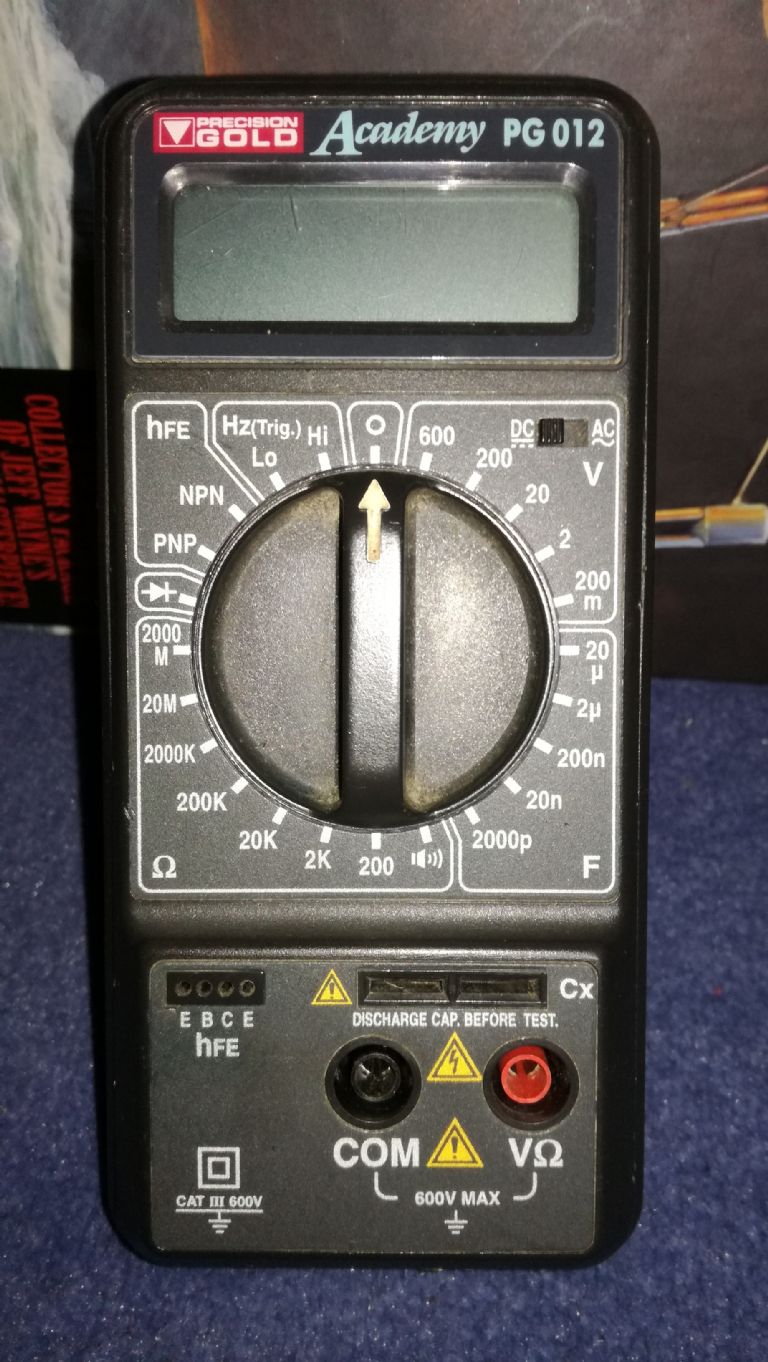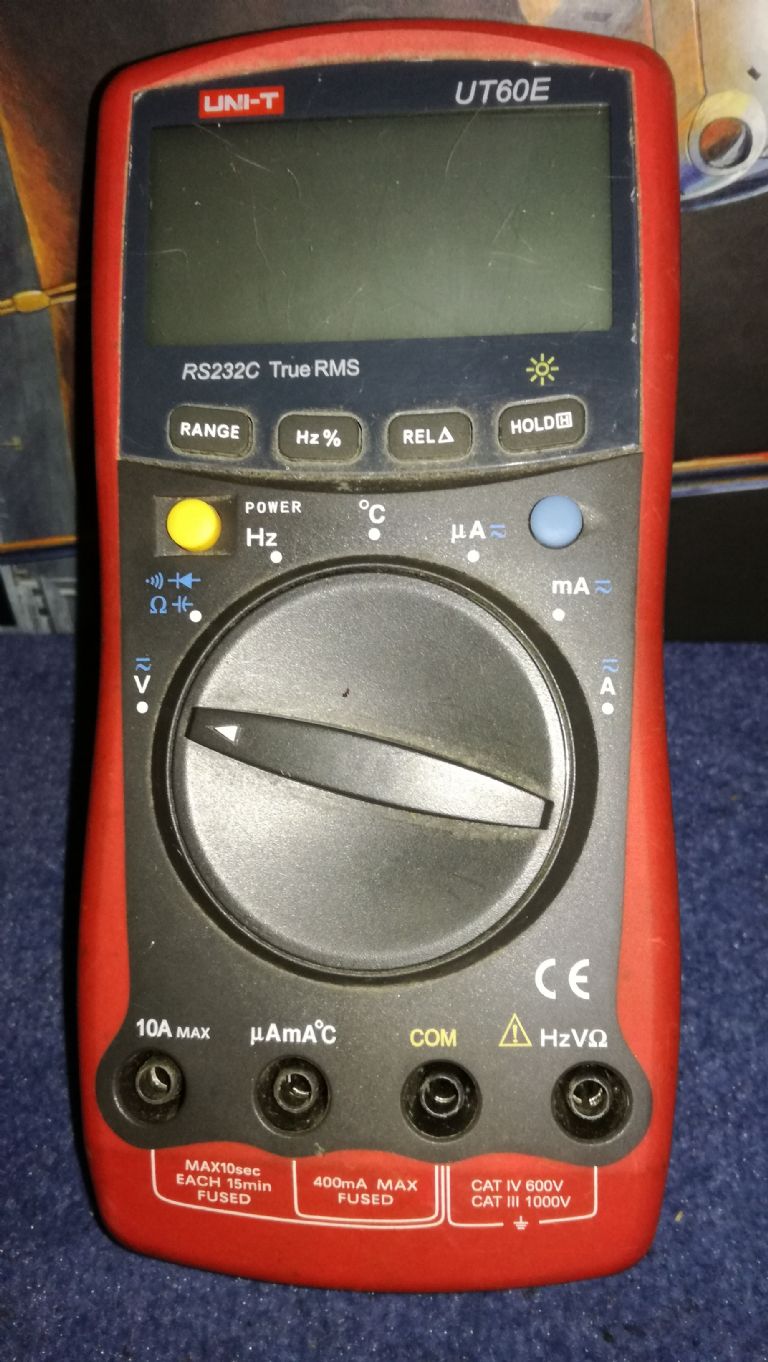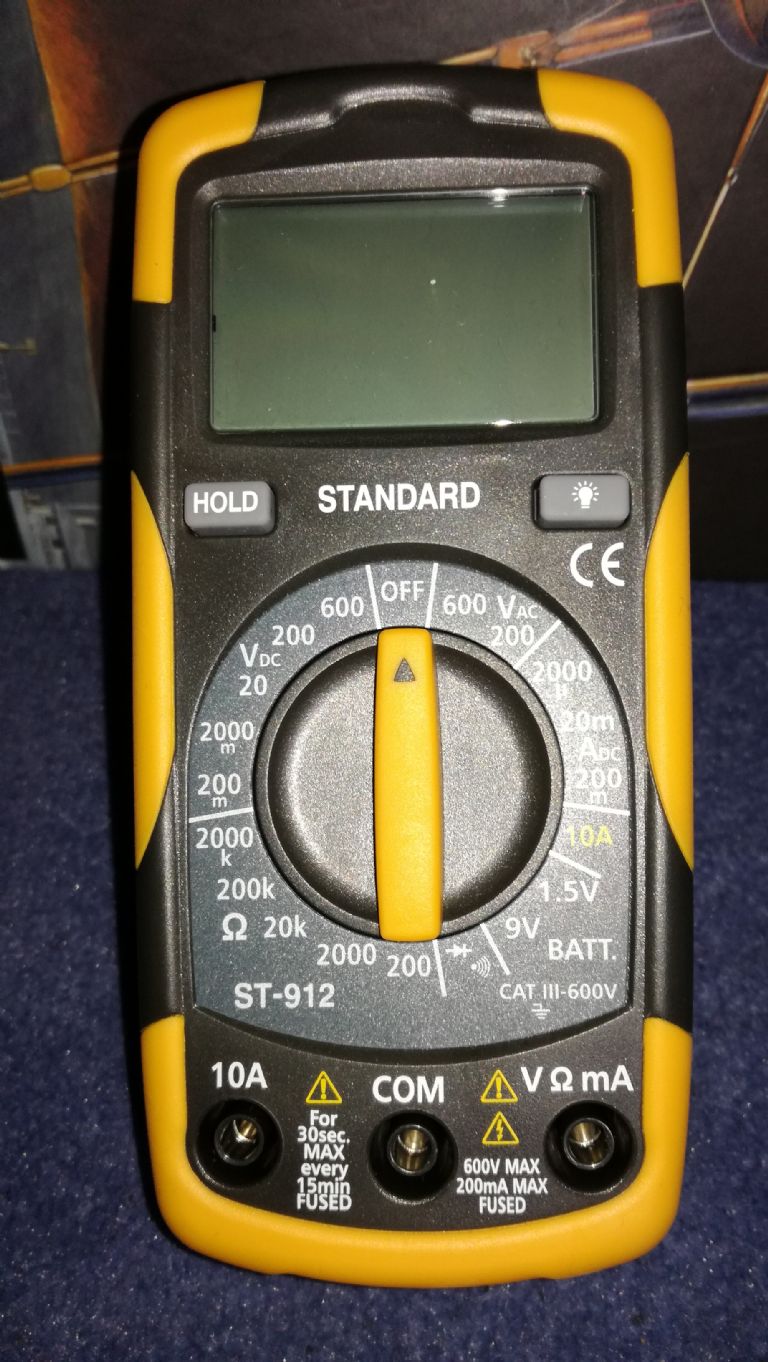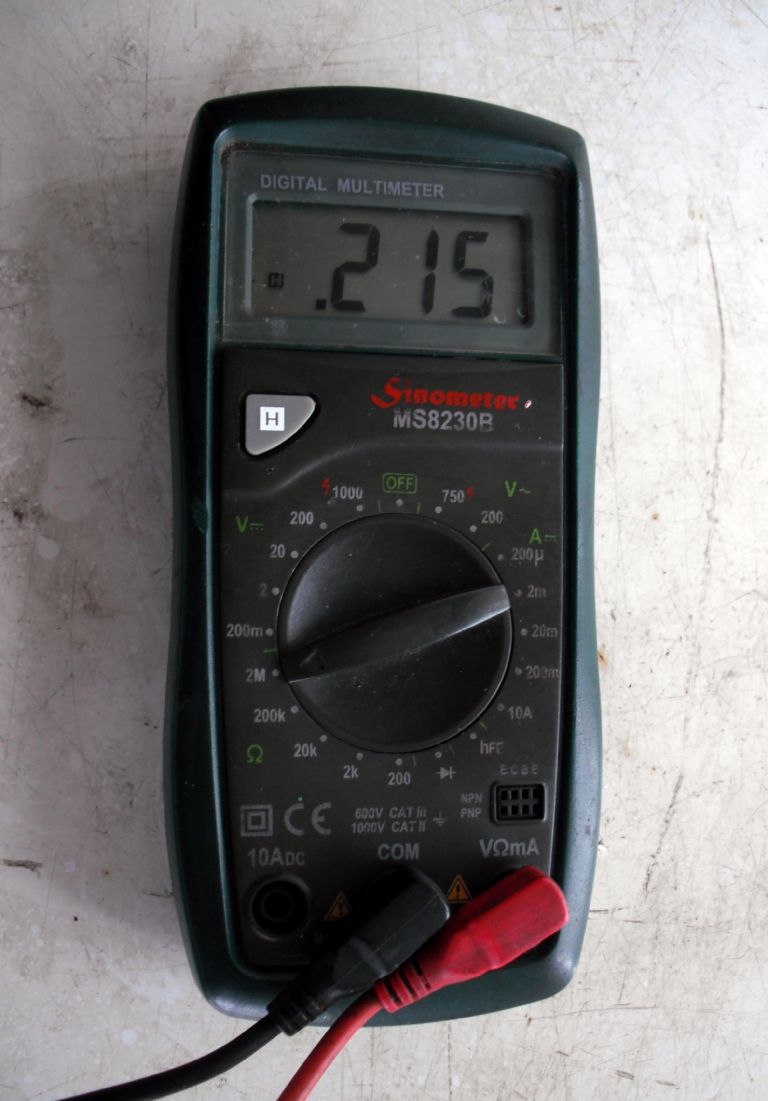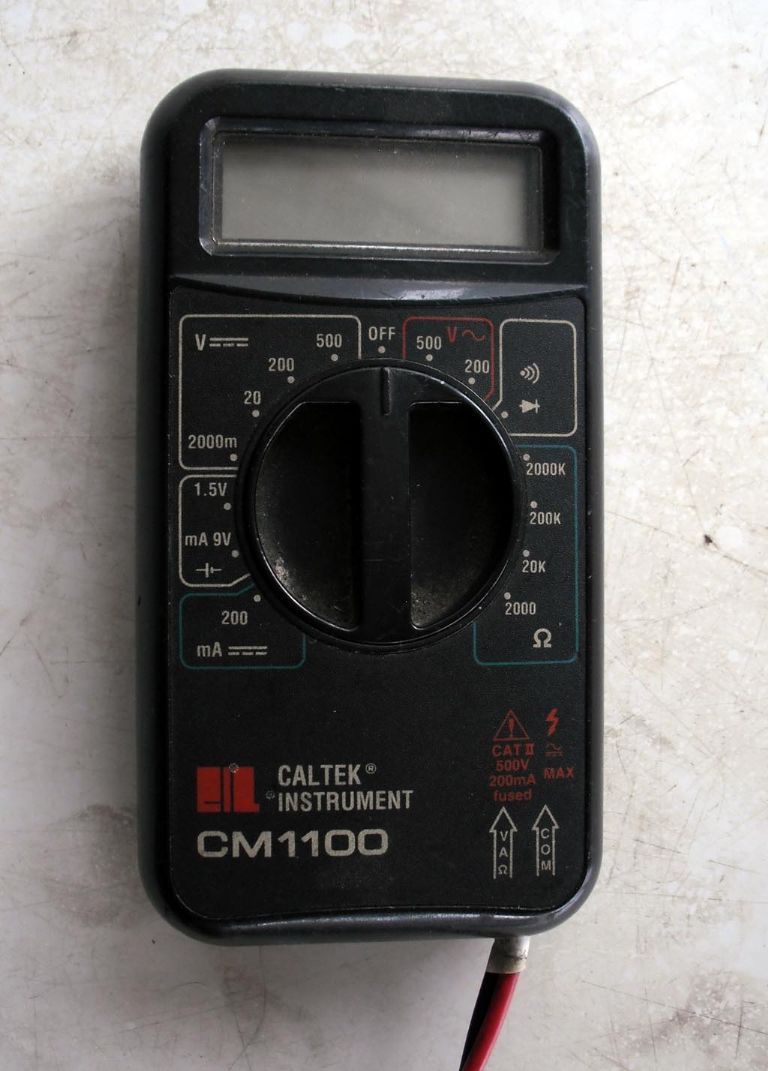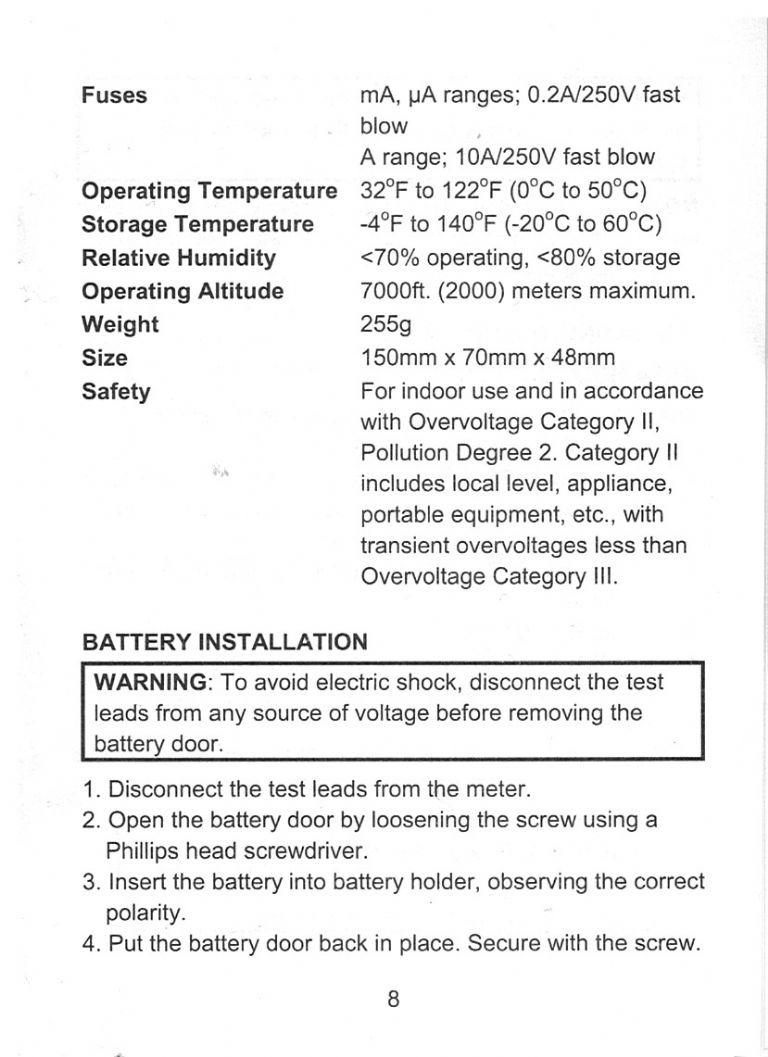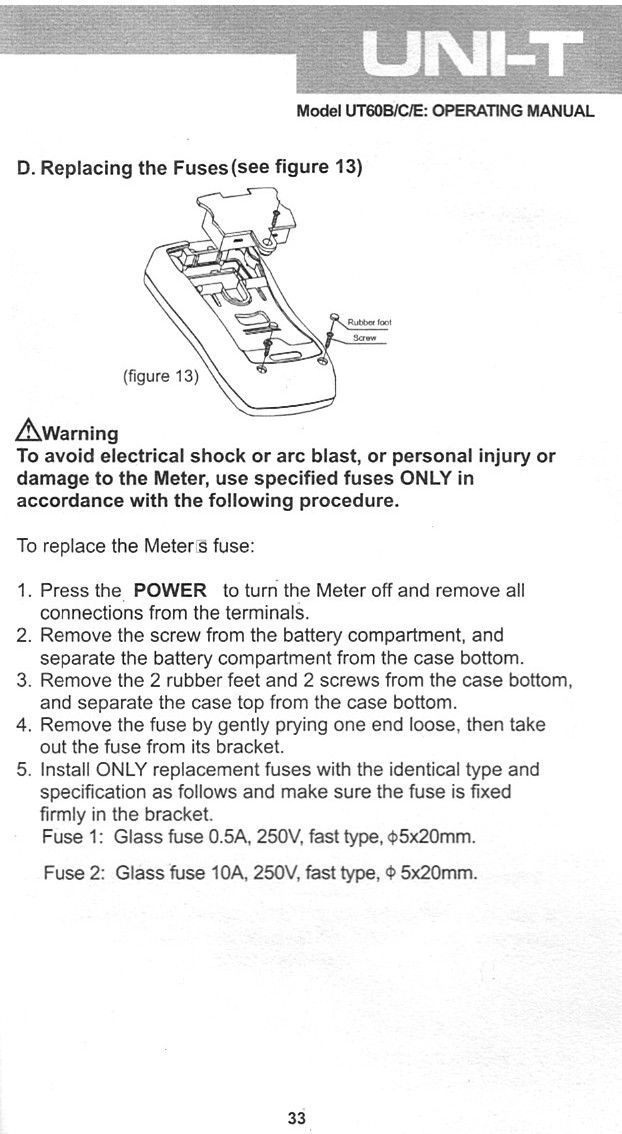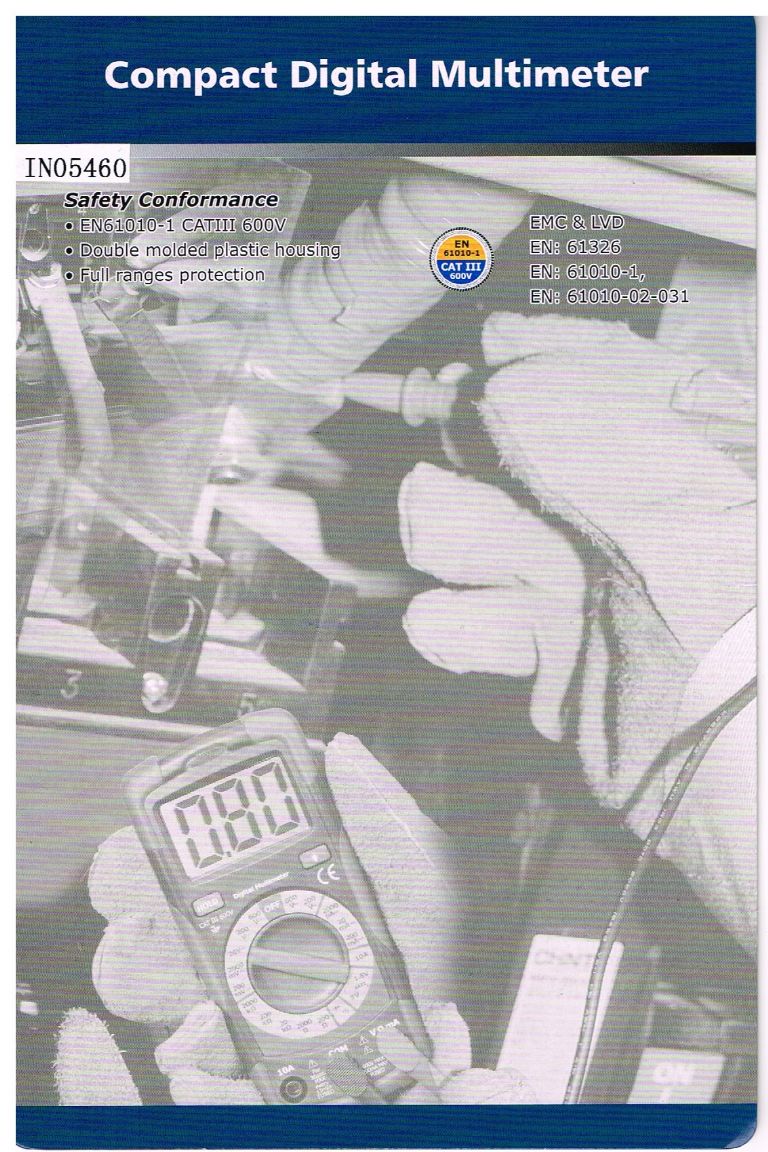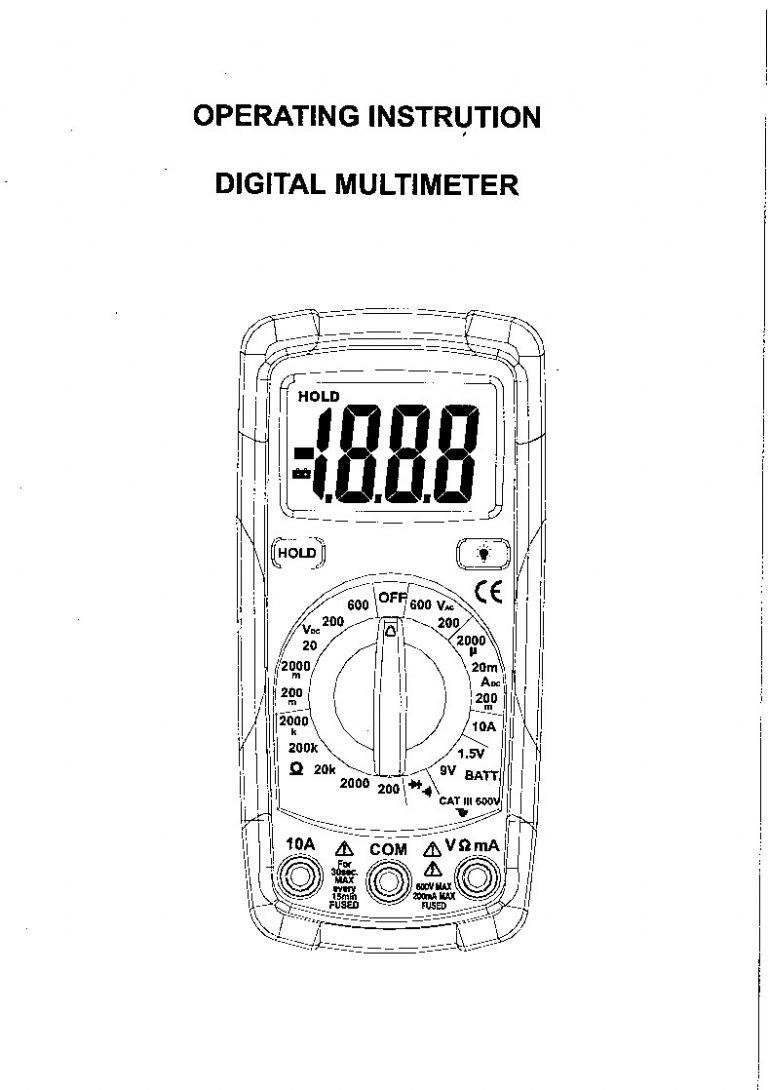Multimeter recommendations
Multimeter recommendations
Home › Forums › Electronics in the Workshop › Multimeter recommendations
- This topic has 103 replies, 41 voices, and was last updated 26 September 2021 at 22:20 by
 Michael Gilligan.
Michael Gilligan.
-
AuthorPosts
-
9 September 2021 at 12:32 #562031
 Michael GilliganParticipant@michaelgilligan61133
Michael GilliganParticipant@michaelgilligan61133An excellent fact-check, Dave

MichaelG.
9 September 2021 at 19:41 #562099 Robert Atkinson 2Participant@robertatkinson2
Robert Atkinson 2Participant@robertatkinson2SOD's picture of a Maplin meter is typical of a "830" type meter sold under many brands fron a few pounds up. Better than nothing, but not safe for use on mains or high energy circuits.
The reason cheap meters give a 10A DC range is because it is easy to provide an inaccurate, unprotected 10A range (it's the loop of wire next to the input sockets in the picture). Conversly it is expensive to provide an accurate and protected 10A range.
Likewise the expensive meters don't provide a "transistor test" function because it won't meet the safety requirements due to the small spacing on the socket.Robert G8RPI.
10 September 2021 at 10:50 #562176SillyOldDuffer
Moderator@sillyolddufferPosted by Robert Atkinson 2 on 09/09/2021 19:41:50:SOD's picture of a Maplin meter is typical of a "830" type meter sold under many brands fron a few pounds up. Better than nothing, but not safe for use on mains or high energy circuits.
…
Robert G8RPI.
Is Robert's; 'not safe for use on mains' statement personal opinion or evidenced fact? I ask because the meter claims IEC61010-1 and CAT II on the 600V range, and, as it was sold with a CE mark by a reputable UK supplier, I've no reason to believe it's a fake. Can't take it back now if it's a wrong 'un!
I don't suppose the meter on ohms would survive being connected to the mains, but I don't think it's fundamentally unsafe when used as per instructions. What's the failure mode? If the 200mA fuse failed, I think the fine PCB tracks would fuse inside the box ; the instrument fails safe, unlike the much more heavily built AVO which depends on a 60 year old thermal cut-out.
The cheap meter's 10A shunt isn't a simple loop: the shunt has a notch full of solder and is presumably it's own fuse. Not quite the Widow-maker Robert fears. Whether all examples of this generic type of meter pay the same attention to detail is another question!
Dave
PS. I agree the Maplin meter is too flimsy for working on switchgear!
10 September 2021 at 11:02 #562179 Ady1Participant@ady1
Ady1Participant@ady1I got a nice amateurs unit, a Vichy 99 but they don't seem to sell it here anymore
import only
Edited By Ady1 on 10/09/2021 11:04:18
10 September 2021 at 11:28 #562180KWIL
Participant@kwilI bought my AVO8 (Tropical version) in 1959 brand new and it cost me the princely sum of £55. Still going strong today.
Replaced the leads and clips for later versions. Works for me. Throw away cheap meters have their uses however.
10 September 2021 at 12:02 #562187Stuart Bridger
Participant@stuartbridger82290About 35 years ago, a short part of my career was spent both using and repairing AVO multimeters.
The company I worked for had several hundred that were on a 6 monthly calibration cycle. If they failed calibration, they came to our department for repair. It could be a very time consuming task depending on the fault. Two faults filled us with dread, one was rotary switch replacement when the contacts wore out, as it was a complete strip down.
The second was the overload cut-out, which was a fiendishly cunning mechanical system that relied on the acceleration of the movement pointer to open a push to reset switch. It was real knack to get this this to trip or not to trip within specification.Also we went out of "field jobs" outside of the workshop around the factory. If an Avo was needed this went in the basket of a butchers style trade bike as they were damned heavy to carry any distance. Hand held Fluke DMMs were a godsend as they would just fit in a lab coat pocket.
10 September 2021 at 12:51 #562196 Nicholas FarrParticipant@nicholasfarr14254
Nicholas FarrParticipant@nicholasfarr14254Hi, well here's my line up of digital multimeters, first one is Maplin's precision gold range and must be nearly 20 years or more old. It is cat III 600V and has measured the mains umpteen times without any issue, but there is no current measurements to worry about. I have compared it to a good known professional multimeter at one time and the results were not different enough to be concerned about. It can be seen that it has transistor and capacitor testing, I can't remember exactly how much it cost, but think it was in the £25 range at the time and this was my first digital multimeter I had, previous ones were analogue, which I do still have but rarely use them now.
This next one is a UNI-T which I bought from Maplin's for around £35-£40, a fair while before they closed their stores. It is auto-ranging, but the ranges can be set manually, it is cat IV 600V and cat III 1000V and does have DC and AC current in all ranges but no transistor testing, it has also been used to measure the mains. All the readings compare very well with the above one with no drift worth any mention.
This next one I received yesterday, I really only bought it to save me paying postage costs on another two items, but I chose it really for the battery test function although it seems to be a good general overall use one. This is also cat III 600V and cost £11.94 from CPC/Farnell. Haven't use it yet, so don't know how it compares with any of the two above.
This last one is completely different as it doesn't measure volts or amps but it does have Inductance measuring, resistance, capacitance and transistor testing. I think I bought it about 18 months or so ago and it cost in about the £35 range, again from CPC and it was the inductance range that I wanted. I've measured a few commercially made chokes that have been marked with tolerances on and has been in the same ball-park close enough not to make any effect for what I would use it for. Just have to remember not to put it across any voltage, but it only has leads that are 170mm long including the crocodile clips, so I shouldn't really confuse it with any other meter.
Regards Nick.
Edited By Nicholas Farr on 10/09/2021 13:04:40
10 September 2021 at 13:53 #562218Anthony Knights
Participant@anthonyknights16741When I was working, the company issued the engineers with "Fluke" meters. When I retired, mine had to be returned, so I bought this one from Maplin for about £20 at the time. Since then I have not noticed a difference in performance between this and the Fluke. The same model is currently on sale at Amazon for about £45.

At the other extreme is this one, which also came from Maplin and on Amazon at the princely sum of £9.99
I can't remember how much I paid for it but not a lot. It is very similar in size and shape to the first moving coil meter I ever got (now long gone)
10 September 2021 at 16:59 #562244 Robert Atkinson 2Participant@robertatkinson2Posted by SillyOldDuffer on 10/09/2021 10:50:17:Posted by Robert Atkinson 2 on 09/09/2021 19:41:50:
Robert Atkinson 2Participant@robertatkinson2Posted by SillyOldDuffer on 10/09/2021 10:50:17:Posted by Robert Atkinson 2 on 09/09/2021 19:41:50:SOD's picture of a Maplin meter is typical of a "830" type meter sold under many brands fron a few pounds up. Better than nothing, but not safe for use on mains or high energy circuits.
…
Robert G8RPI.
Is Robert's; 'not safe for use on mains' statement personal opinion or evidenced fact? I ask because the meter claims IEC61010-1 and CAT II on the 600V range, and, as it was sold with a CE mark by a reputable UK supplier, I've no reason to believe it's a fake. Can't take it back now if it's a wrong 'un!
I don't suppose the meter on ohms would survive being connected to the mains, but I don't think it's fundamentally unsafe when used as per instructions. What's the failure mode? If the 200mA fuse failed, I think the fine PCB tracks would fuse inside the box ; the instrument fails safe, unlike the much more heavily built AVO which depends on a 60 year old thermal cut-out.
The cheap meter's 10A shunt isn't a simple loop: the shunt has a notch full of solder and is presumably it's own fuse. Not quite the Widow-maker Robert fears. Whether all examples of this generic type of meter pay the same attention to detail is another question!
Dave
PS. I agree the Maplin meter is too flimsy for working on switchgear!
There is no way that the meter pictured is CAT II 600V compliant. This is a FACT. I can 100% from just one obvious feature – the 20mm glass fuse. No 20mm plain glaas fuse is capable of safely breaking the fault current on even a domestic electrical supply. Compare with the sand filled thick wall ceramic fuse in a 13A plug.
To satisfy yourself pull the fuse and see if it is rated for 600V AC. I bet it is not. For example Farnell do not list a single 600V 20mm fuse
https://uk.farnell.com/c/circuit-protection/fuses-fuse-accessories/fuses/cartridge-fuses?st=20mm%20fuseThe clearance and creapage on the input connector sockets and fuse also appears inadequate but I'd have t measure it to be sure.
The blob of solder on the 10A shunt is not a fuse. it's probably an attempt to calibrate the 10A range after they filled the notch in their first attempt too deep. It could also just be a random blob of solder, or a blind copy of another meter without knowing why it was there or any attempt at calibration.
Robert G8RPI.
10 September 2021 at 17:45 #562248 Robert Atkinson 2Participant@robertatkinson2
Robert Atkinson 2Participant@robertatkinson2note " The main criteria is that all inputs must be able to withstand the maximum CAT ratings in all modes of operation, connected incorrectly or not, without harming the user. Current measurement protection must meet the CAT voltage rating as well, in other words fuses used must be rated for the maximum CAT rating on the meter."
I forgot to include the unfused current range in my earlier post..
Your Maplin is on the list " Any Meter with the model number "830" All of these low priced meters are junk just waiting to blow up in your hand. "Robert G8RPI.
10 September 2021 at 19:20 #562266 Nicholas FarrParticipant@nicholasfarr14254Posted by Robert Atkinson 2 on 10/09/2021 17:45:36:
Nicholas FarrParticipant@nicholasfarr14254Posted by Robert Atkinson 2 on 10/09/2021 17:45:36:note " The main criteria is that all inputs must be able to withstand the maximum CAT ratings in all modes of operation, connected incorrectly or not, without harming the user. Current measurement protection must meet the CAT voltage rating as well, in other words fuses used must be rated for the maximum CAT rating on the meter."
I forgot to include the unfused current range in my earlier post..
Your Maplin is on the list " Any Meter with the model number "830" All of these low priced meters are junk just waiting to blow up in your hand. "Robert G8RPI.
Hi Robert, I'm not disagreeing with you, however this brand new meter from CPC that I have, it states the fuses as being 250V fast blowing, which has been factory fitted with glass ones.
The instructions for my UNI-T say they must be glass fuse 250V fast type.
So have both of these manufacturers got it wrong?
Regards Nick.
Edited By Nicholas Farr on 10/09/2021 19:25:29
10 September 2021 at 20:13 #562271duncan webster 1
Participant@duncanwebster1I've learned something from this thread, always good. Anyone know where I can get fuses for a Fluke at a sensible price?, £10 a pop is a bit ott. It's a type 87 serial 62430186 and on the back it says F 1A 600V, F15A 600V. Interweb searches suggest 11A and 440mA, which seems sensible as they are +10% on the max for each range. It appears something changed after number 65650000. I can't imagine using the lower rating would matter
Clearly BS 1362 fuses are good for 250V AC, how about the DC rating? Or BS2956A 1.25" glass, these have 250V engraved on the end.
10 September 2021 at 20:34 #562275 Robert Atkinson 2Participant@robertatkinson2
Robert Atkinson 2Participant@robertatkinson2Hi Nick,
Yes, either inadvertently or by deception, I can't tell which, they are claiming compliance with CAT standards that they cannot meet.
This may be because they misguidedly do their own analysis of compliance and get it wrong. Even Fluke don't do this, they send their meters for independent verification.The requirement is that applying a high energy source at the maximum rated voltage to ANY combination of inputs in ALL switch positions will not cause a hazard. A hazard includes shock, sparks or explosion. The amount of energy appiled goes up with the CAT rating number even if the voltage is the same. This is bsed on the FAULT current the supply it is intended to be used on can supply. This can be thousands of amps.
There are two things to note:
1/ This is for protection against spikes or surges on the supply or mis-application of the meter.
2/ The meter does not have to work after the test.It can be seen that unless there is a problem with the powersupply or the meter is mis-used not having a fully complinat meter has no effect. It's only when something goes wrong that you will find out the the meter is deficient in it's protction. By then of course it is too late.
The big issue is that there is no enforcement of compliance. Trading standards don't have a buget to send meters for testing.Robert G8RPI.
11 September 2021 at 09:24 #562321 Robert Atkinson 2Participant@robertatkinson2Posted by duncan webster on 10/09/2021 20:13:23:
Robert Atkinson 2Participant@robertatkinson2Posted by duncan webster on 10/09/2021 20:13:23:I've learned something from this thread, always good. Anyone know where I can get fuses for a Fluke at a sensible price?, £10 a pop is a bit ott. It's a type 87 serial 62430186 and on the back it says F 1A 600V, F15A 600V. Interweb searches suggest 11A and 440mA, which seems sensible as they are +10% on the max for each range. It appears something changed after number 65650000. I can't imagine using the lower rating would matter
Clearly BS 1362 fuses are good for 250V AC, how about the DC rating? Or BS2956A 1.25" glass, these have 250V engraved on the end.
The problem with using 250V fuses is that they don't meet the 600V CAT rating of the meter. You might know this but what if somone else uses the meter and does not?. Note that the fuse in a meter has to be safe for surges and spikes on the supply so 250V fuses would not pass for a DMM CAT rating by analysis even at 240V nominal mains.
If the fuses need replacing it means someone has made a mistake before and the protection worked, do you want to risk it the next time?
" You got to ask yourself, do I feel lucky? Well do yah punk?"*
Robert G8RPI.
*Dirty Harry 1971, You are playing russian roulette when you use a non CAT compliant meter on mains. Mains has a lot more energy than a 44 magnum.
11 September 2021 at 10:29 #562343 Nicholas FarrParticipant@nicholasfarr14254
Nicholas FarrParticipant@nicholasfarr14254Hi Robert, thanks for answering my question and with that it is a little disconcerting that a company like Farnell are associated with the sale of these multimeters if they are not up to the category they claim to be. However, I do know the fuses only protect the current measuring sections and I'm highly unlikely to be measuring any amperage on high energy circuits and most likely never on any 3 phase installations.
I have been reading this Fluke Safety Guide Lines which is very interesting, but on page five, they do say to replace any fuses with those that match the manufacturers high energy fuses that they specify. I'm also aware by the presents of the lightning symbol in the triangle on my new meter, that the meter and it's leads should not be handled when high energy circuits are connected, but this was mentioned years ago with my old Maplin analogue multimeters that the meter should be connected while any high energy circuits are turned off and should not be handle during any tests and then removed only when the circuit is turn off again.
Regards Nick.
Edited By Nicholas Farr on 11/09/2021 10:43:24
11 September 2021 at 11:07 #562352SillyOldDuffer
Moderator@sillyolddufferPosted by Robert Atkinson 2 on 11/09/2021 09:24:44:Posted by duncan webster on 10/09/2021 20:13:23:…
The problem with using 250V fuses is that they don't meet the 600V CAT rating of the meter…
Is that true, or an assumption? From LittelFuse, who invented them, my bold:
In electronic equipment with relatively low output power
supplies, with circuit impedance limiting short circuit
currents to values of less than ten times the current rating
of the fuse, it is common practice to specify fuses with
125 or 250 volt ratings for secondary circuit protection of
500 volts or higher.Does anyone have access to IEC61010-1?
Possibly Fluke meters are designed to survive blowing a fuse, whereas the cheaper meters are disposable. In them the fuse protects the operator, not the instrument, which goes in the bin.
What's the most destructive test I could put my spare M-0830B too? With suitable precautions I'm tempted to blow it up deliberately! Could be wrong, I think it's light construction will cause the board to pop inside the case rather than explode or catch fire. Pity Maplin have gone bust and I can't ask them: be good to see their documentation justifying the CE mark.
Dave
11 September 2021 at 12:03 #562363 Robert Atkinson 2Participant@robertatkinson2Posted by SillyOldDuffer on 11/09/2021 11:07:55:Posted by Robert Atkinson 2 on 11/09/2021 09:24:44:Posted by duncan webster on 10/09/2021 20:13:23:
Robert Atkinson 2Participant@robertatkinson2Posted by SillyOldDuffer on 11/09/2021 11:07:55:Posted by Robert Atkinson 2 on 11/09/2021 09:24:44:Posted by duncan webster on 10/09/2021 20:13:23:…
The problem with using 250V fuses is that they don't meet the 600V CAT rating of the meter…
Is that true, or an assumption? From LittelFuse, who invented them, my bold:
In electronic equipment with relatively low output power
supplies, with circuit impedance limiting short circuit
currents to values of less than ten times the current rating
of the fuse, it is common practice to specify fuses with
125 or 250 volt ratings for secondary circuit protection of
500 volts or higher.Does anyone have access to IEC61010-1?
Possibly Fluke meters are designed to survive blowing a fuse, whereas the cheaper meters are disposable. In them the fuse protects the operator, not the instrument, which goes in the bin.
What's the most destructive test I could put my spare M-0830B too? With suitable precautions I'm tempted to blow it up deliberately! Could be wrong, I think it's light construction will cause the board to pop inside the case rather than explode or catch fire. Pity Maplin have gone bust and I can't ask them: be good to see their documentation justifying the CE mark.
Dave
Hi Dave,
The line you quoted "In electronic equipment with relatively low output power supplies, with circuit impedance limiting short circuit currents to values of less than ten times the current rating of the fuse"
Is the key.
We are not talking about electronic equipment or low impdence circuits limiting currents, we are talking about MAINS SUPPLIES and their ability to supply currents in the thousands of amps before the supply fuse opens.
And no, a RCD does not help because we are talking about live to neutral currrents. The only thing limiting the peak current is the circuit impedance which is a fraction of an Ohm. Even the 10A shunt in a meter is typically 0.01 Ohm so peak current across the mains(at 240V RMS nominal) is roughly 34,000 amps (240×1.414 / 0.01) Actully a bit less due to wiring imedance etc, but it's still thousands of amps.. This is assuming you connect the meter across the mains on 10A range by accident which is what CAT ratings are about.Robert G8RPI.
11 September 2021 at 13:00 #562373 Robert Atkinson 2Participant@robertatkinson2
Robert Atkinson 2Participant@robertatkinson2Dave (SOD) also said " I think it's light construction will cause the board to pop inside the case …"
I agree, and that would be a failure of the CAT test. A flash arcing) caused by vapourising a conductor is considered a hazard. That is why high breaking current (not fusing) rated fuses have sand filling and tough ceramc or composite bodies, to contin the flash.
I've carried out high energy discharge tests and you don't want to be on the wrong side of the safety screen!
From IEC 61010-1
"16.2 Multifunction meters and similar equipment
Multifunction meters and similar equipment shall not cause a HAZARD in any possible combination
of RATED input voltages, and settings of function and range controls. Possible HAZARDS include
electric shock, fire, arcing and explosion.
Conformity is checked by the following test.The maximum RATED voltage specified for any function is applied to each pair of TERMINALS in
turn, in every combination of function and range controls. The test source connected to the
equipment measuring TERMINALS during this test is limited to 3.6 kVA for measurement category I
or measurement category II. For measurement category III or measurement category IV, the test
circuit has to be capable of delivering 30 kVA.During and after the tests, no HAZARD shall arise.
Multifunction meters and similar equipment are to be tested by changing the Function/ /Range Selector to all
possible settings while connected to the maximum rated source.”Robert G8RPI.
12 September 2021 at 13:35 #562494 Nicholas FarrParticipant@nicholasfarr1425412 September 2021 at 16:55 #562513
Nicholas FarrParticipant@nicholasfarr1425412 September 2021 at 16:55 #562513SillyOldDuffer
Moderator@sillyolddufferPosted by Robert Atkinson 2 on 11/09/2021 13:00:40:
From IEC 61010-1
"16.2 Multifunction meters and similar equipment
Multifunction meters and similar equipment shall not cause a HAZARD in any possible combination
of RATED input voltages, and settings of function and range controls. Possible HAZARDS include
electric shock, fire, arcing and explosion.
Conformity is checked by the following test.The maximum RATED voltage specified for any function is applied to each pair of TERMINALS in
turn, in every combination of function and range controls. The test source connected to the
equipment measuring TERMINALS during this test is limited to 3.6 kVA for measurement category I
or measurement category II. For measurement category III or measurement category IV, the test
circuit has to be capable of delivering 30 kVA.During and after the tests, no HAZARD shall arise.
Multifunction meters and similar equipment are to be tested by changing the Function/ /Range Selector to all
possible settings while connected to the maximum rated source.”Robert G8RPI.
Excellent to see what IEC 61010-1 actually says! I think it can be read two ways, one of which is Robert's strict interpretation, the other much less onerous. As Devil's Advocate:
First, the successful test is one in which there is no HAZARD. I argue this means it doesn't matter what happens inside the case provided the explosion, fire and arc are contained and can't physically harm or shock the operator. A hand grenade could be safely exploded inside a sufficiently strong box. The contents would be completely wrecked, and the box bulged, but I claim it's a pass.
Secondly, what's meant by 'The maximum RATED voltage specified for any function is applied to each pair of TERMINALS in turn, in every combination of function and range controls.'? I could argue it doesn't mean 600VAC must be applied to all the terminals and switch settings. For example, my less rigorous interpretation is that the maximum RATED voltage on the 200mV DC range function is only 200mV, not 600VAC. Not difficult.
Thirdly, the input energy of a CAT I or CAT II test is limited to 3.5KVA, which is far less than a sand-filled mains fuse has to cope with. Even if the meter disintegrates inside the box, 3.5kVA isn't spectacular unless the current continues to flow. I argue there's no particular reason why it should, and in practice all those thin PCB tracks will break almost instantly. It's another pass.
Just a hypothesis. Though I suggest an overloaded M-830 would still fail safely, with minimum HAZARD, I don't know! However, if my sophistries are correct, it might explain why weedy multimeters are CE marked and equally acceptable for sale in the USA and all other administrations around the world. They can't all be fakes can they? Maybe IEC 61010-1 isn't that demanding, or perhaps all the testers have been bamboozled by smart lawyers!

Dave
PS. I actually sympathise with Robert's line on electrical safety: in practice I'm pretty careful with volts and amps.
12 September 2021 at 17:53 #562522duncan webster 1
Participant@duncanwebster1I've bought the proper fuses for my Fluke, found them at £5 each. At least my widow will be able to sue Mr Fluke if I get blown up.
It would be interesting to get Farnell and RS comments on this thread, but I'll not hold my breath
12 September 2021 at 18:36 #562525Bob Worsley
Participant@bobworsley31976Perhaps the clamp ammeter is the way to go? No high current clearing needed, just the ability to withstand 1000V on an uninsulated wire.
12 September 2021 at 19:34 #562533 Robert Atkinson 2Participant@robertatkinson2Posted by Nicholas Farr on 12/09/2021 13:35:37:
Robert Atkinson 2Participant@robertatkinson2Posted by Nicholas Farr on 12/09/2021 13:35:37:Hi Robert, for your information, this is the card that was in the packet that my new multimeter came in, which claims it's conformance of EN61010-1 CAT III. All I can do is accept what it says.
Regards Nick.
Edited By Nicholas Farr on 12/09/2021 13:44:31
Hi Nick, I assume that paperwork came with t "STANDARD" ST913 in your earlier picture. If that is the case I can say it is incorrect just from your picture. Theis is because there is no CAT rating next to the input terminals.
Additionally the paperwork does not reference a model number and the make of the meter in the picture does not ppear to be STANDARD. If you read the link I posted earlier there are ots of meters that dont meet the declared CAT standard. Did the suppliers catalog or web listing actually state it was CAT III 600V?
Likewise your UNI-T UT61 is non compliant because the rating has only been appled to the Volts/ Ohms terminals. A meter has to pass on ALL inputs and functions to be compliant. Current ranges are harder than voltage to make compliant.
Manufacturers and suppliers make all sorts of incorrect or plain fradulent claims.
Robert G8RPI
12 September 2021 at 19:49 #562536 Robert Atkinson 2Participant@robertatkinson2Posted by SillyOldDuffer on 12/09/2021 16:55:36:
Robert Atkinson 2Participant@robertatkinson2Posted by SillyOldDuffer on 12/09/2021 16:55:36:Posted by Robert Atkinson 2 on 11/09/2021 13:00:40:
From IEC 61010-1
"16.2 Multifunction meters and similar equipment
Multifunction meters and similar equipment shall not cause a HAZARD in any possible combination
of RATED input voltages, and settings of function and range controls. Possible HAZARDS include
electric shock, fire, arcing and explosion.
Conformity is checked by the following test.The maximum RATED voltage specified for any function is applied to each pair of TERMINALS in
turn, in every combination of function and range controls. The test source connected to the
equipment measuring TERMINALS during this test is limited to 3.6 kVA for measurement category I
or measurement category II. For measurement category III or measurement category IV, the test
circuit has to be capable of delivering 30 kVA.During and after the tests, no HAZARD shall arise.
Multifunction meters and similar equipment are to be tested by changing the Function/ /Range Selector to all
possible settings while connected to the maximum rated source.”Robert G8RPI.
Excellent to see what IEC 61010-1 actually says! I think it can be read two ways, one of which is Robert's strict interpretation, the other much less onerous. As Devil's Advocate:
First, the successful test is one in which there is no HAZARD. I argue this means it doesn't matter what happens inside the case provided the explosion, fire and arc are contained and can't physically harm or shock the operator. A hand grenade could be safely exploded inside a sufficiently strong box. The contents would be completely wrecked, and the box bulged, but I claim it's a pass.
Secondly, what's meant by 'The maximum RATED voltage specified for any function is applied to each pair of TERMINALS in turn, in every combination of function and range controls.'? I could argue it doesn't mean 600VAC must be applied to all the terminals and switch settings. For example, my less rigorous interpretation is that the maximum RATED voltage on the 200mV DC range function is only 200mV, not 600VAC. Not difficult.
Thirdly, the input energy of a CAT I or CAT II test is limited to 3.5KVA, which is far less than a sand-filled mains fuse has to cope with. Even if the meter disintegrates inside the box, 3.5kVA isn't spectacular unless the current continues to flow. I argue there's no particular reason why it should, and in practice all those thin PCB tracks will break almost instantly. It's another pass.
Just a hypothesis. Though I suggest an overloaded M-830 would still fail safely, with minimum HAZARD, I don't know! However, if my sophistries are correct, it might explain why weedy multimeters are CE marked and equally acceptable for sale in the USA and all other administrations around the world. They can't all be fakes can they? Maybe IEC 61010-1 isn't that demanding, or perhaps all the testers have been bamboozled by smart lawyers!

Dave
PS. I actually sympathise with Robert's line on electrical safety: in practice I'm pretty careful with volts and amps.
Hi Dave I think it is clear that it is the maximum CAT rated voltage that has to be applied. Thus if a unit is CATII 600V even if the equipment specification says 500V max, the test applies 600V. Also the same voltage is applied to all termin combinations on all switch settings. This is common sense as there is nothing to stop the operator setting up for current measurement and then connecting between live and neutral instead of live and load. In safety terms this is a "slip" and has to be expected.
The hazard of arcing includes internal arcing. If this was not the case Fluke etc would not use expensive fuses designed to contain the intentional arc of them fusing. An uncontained arc can lead to other hazards.
No "830" meter is really safe for use on the mains.Robert G8RPI.
12 September 2021 at 19:57 #562539 Nicholas FarrParticipant@nicholasfarr14254
Nicholas FarrParticipant@nicholasfarr14254Hi Robert, this is the one that I purchased from CPC/Farnell.com TEN01061
This is the front page of the instructions, it doesn't have the standard or the ST-912 printed, but all the specifications printed inside match what is stated on the front of the meter.
The test leads supplied have CAT III 1000V CAT IV 600V and also the CE and the double insulation symbol and 10A with the Earth symbol, moulded into both of the probes.
Regards Nick.
Edited By Nicholas Farr on 12/09/2021 20:29:51
-
AuthorPosts
- Please log in to reply to this topic. Registering is free and easy using the links on the menu at the top of this page.
Latest Replies
Home › Forums › Electronics in the Workshop › Topics
-
- Topic
- Voices
- Posts
- Last Post
-
-
Speed camera
1
2
Started by:
 David George 1
in: The Tea Room
David George 1
in: The Tea Room
- 22
- 46
-
3 July 2025 at 23:51
not done it yet
-
Bentley BR2 Rotary Aero Engine
Started by:
notlobgp14 in: Miscellaneous models
- 2
- 3
-
3 July 2025 at 21:48
notlobgp14
-
Starrett micrometer.
Started by:
Graeme Seed in: Workshop Tools and Tooling
- 5
- 10
-
3 July 2025 at 21:25
 peak4
peak4
-
Hemmingway rotary broaching kit
Started by:
YouraT in: Workshop Tools and Tooling
- 1
- 1
-
3 July 2025 at 21:21
YouraT
-
Boxford lathe & vertical mill VFD conversion help with start stop
Started by:
Andrew Schofield in: Beginners questions
- 2
- 2
-
3 July 2025 at 21:18
 Robert Atkinson 2
Robert Atkinson 2
-
Firth Valve Gear
Started by:
Andy Stopford in: Traction engines
- 10
- 20
-
3 July 2025 at 21:14
Andy Stopford
-
A grasshopper of unknown vintage
Started by:
mikemunson in: Stationary engines
- 3
- 3
-
3 July 2025 at 20:21
Charles Lamont
-
New (but well aged) member
Started by:
mikemunson in: Introduce Yourself – New members start here!
- 4
- 4
-
3 July 2025 at 19:55
noel shelley
-
New member from Lancashire
Started by:
mannyroad in: Introduce Yourself – New members start here!
- 7
- 15
-
3 July 2025 at 19:14
notlobgp14
-
Bearing boxes for ball race
Started by:
Paul McDonough in: Beginners questions
- 10
- 19
-
3 July 2025 at 18:35
Paul McDonough
-
Twin Engineering’s heavy mill/drill quill removal
Started by:
Martin of Wick in: Manual machine tools
- 10
- 21
-
3 July 2025 at 17:53
 David George 1
David George 1
-
Loctite axles
Started by:
steve2250 in: General Questions
- 5
- 6
-
3 July 2025 at 12:22
parovoz
-
Comments (constructive) on the New Forum Software
1
2
…
34
35
Started by:
 JasonB
in: New Forum Software questions, comments and Test Threads
JasonB
in: New Forum Software questions, comments and Test Threads
- 134
- 875
-
3 July 2025 at 10:25
Emgee
-
Grimsby & Cleethorpes MES on the BBC
Started by:
Chris Crew in: The Tea Room
- 1
- 1
-
3 July 2025 at 08:51
Chris Crew
-
Injectors
Started by:
pansy123 in: General Questions
- 6
- 7
-
3 July 2025 at 07:05
Dave Wootton
-
Pattern Makers Vice
Started by:
 Vic
in: The Tea Room
Vic
in: The Tea Room
- 7
- 9
-
2 July 2025 at 21:51
 KEITH BEAUMONT
KEITH BEAUMONT
-
J&S grinder – belt which way ?
Started by:
gerry madden in: Manual machine tools
- 7
- 9
-
2 July 2025 at 21:44
not done it yet
-
Meddings MF4 Manual
Started by:
Richard Kirkman 1 in: Help and Assistance! (Offered or Wanted)
- 11
- 23
-
2 July 2025 at 21:38
Richard Kirkman 1
-
Haining vertical dairy engine boiler.
Started by:
apprentice in: Beginners questions
- 3
- 7
-
2 July 2025 at 20:52
 JasonB
JasonB
-
Motor won’t start
Started by:
Rowan Sylvester-Bradley in: Beginners questions
- 9
- 9
-
2 July 2025 at 17:30
larry phelan 1
-
IME Watchmakers lathe
Started by:
Greensands in: Manual machine tools
- 11
- 16
-
1 July 2025 at 21:41
Dave S
-
Request for a Slot to be Milled in a Shaft
Started by:
James Alford in: Help and Assistance! (Offered or Wanted)
- 9
- 18
-
1 July 2025 at 21:03
bernard towers
-
The Stevenson Trophy – Entries Invited
Started by:
 Neil Wyatt
in: Website Announcements
Neil Wyatt
in: Website Announcements
- 1
- 2
-
1 July 2025 at 18:44
 Neil Wyatt
Neil Wyatt
-
The Bradford Cup – Nominations Wanted
Started by:
 Neil Wyatt
in: Website Announcements
Neil Wyatt
in: Website Announcements
- 1
- 2
-
1 July 2025 at 18:41
 Neil Wyatt
Neil Wyatt
-
FreeCAD v1.0 tutorials
1
2
3
Started by:
 Michael Gilligan
in: CAD – Technical drawing & design
Michael Gilligan
in: CAD – Technical drawing & design
- 12
- 54
-
1 July 2025 at 18:31
Speedy Builder5
-
Speed camera
1
2
-
Latest Issue
Newsletter Sign-up
Latest Replies


